Contents
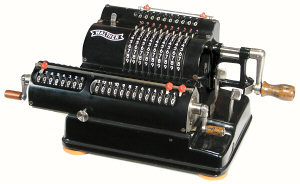
Contents |

|
| Walther Model RMKZ, 1930s |
 The Walther company dates from 1886, when the founder Carl Walther
established a gunsmith business at Zella-Mehlis in Thuringia. By 1903
his staff of 15 were manufacturing hunting and sporting rifles under
the Walther brand. In 1908 Walther's son Fritz designed an automatic
pistol which soon established the company's reputation worldwide.
The Walther company dates from 1886, when the founder Carl Walther
established a gunsmith business at Zella-Mehlis in Thuringia. By 1903
his staff of 15 were manufacturing hunting and sporting rifles under
the Walther brand. In 1908 Walther's son Fritz designed an automatic
pistol which soon established the company's reputation worldwide.
The company survived the 1914-18 war and the ensuing economic turmoil, and soon rebuilt its arms business. Calculating machines were introduced in 1924 to broaden the product line into civilian areas. The first Walther calculator was a hand-cranked pinwheel machine based on the Odhner design. An electrically-driven machine followed in 1929, and a full-keyboard adding and listing machine in 1931. By 1939 the calculator range included 17 different models, with exports to many countries. The company as a whole employed around 2000 people.
During the 1939-45 war the Walther factory was again turned over to military production. The factory was lost during the war, and in 1945 Zella-Mehlis became part of the Russian occupation zone.
After the war Fritz Walther and some of his engineers set out to re-establish the company in West Germany. A new calculator factory was built in 1947 at Gerstetten in Württemberg, and another in 1948 at Nieder-Stotzingen. A new factory for sporting arms was opened nearby at Ulm in 1950.
The first post-war calculator was another pin-wheel machine, which was followed in the early 1950s by a range of ten-key adding and listing machines. This range expanded during the 1960s to include accounting machines, OCR printing systems, and data collection systems for computer-based processing. By 1970 the Walther Office Machines company (Walther Büromaschinen GmbH) employed around 2000 staff and produced almost 120,000 machines per year, with about 50% for export.
A large non-printing electronic calculator (the ETR 1) was sourced from Ricoh in Japan and introduced in 1969, followed by an in-house designed ETR 10 printing calculator later the same year. Two smaller portable machines (ETR 2 and 3) were introduced in 1971. The small machines used a chipset developed by Philips, and sold 10,000 units in the first three months.
The Japanese "calculator wars" of the early 1970s put an end to both the mechanical and the electronic calculator lines. The Walther Office Machines company closed in 1974, although parts of the business continued on as Walther Electronic and Walther Data. Re-badged Japanese calculators continued to appear under the Walther brand until the 1990s. The Carl Walther parent company remained a family-owned business until 1993, and still produces firearms at the factory in Ulm.
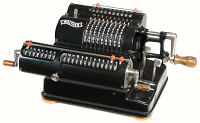 Walther Model RMKZ, S/N 21917
Walther Model RMKZ, S/N 21917
Digits: 10 rotor, 8 counter, 13 accumulator
Dimensions: Body 185W x 130D x 135H, overall width 300mm
Weight: 3.6 kg
Manufactured: Zella-Mehlis, Thuringia (Germany), 1924-1939
The Carl Walther company introduced a line of pinwheel calculators in 1924 to supplement their primary business in sporting firearms. Production continued until the 1939-45 war, then resumed in 1947 in West Germany. This pre-war Model RMKZ was built at the original plant in Zella-Mehlis in the 1930s.
The machine is built from aluminium-alloy castings and is relatively light in weight. It has a setting check dial and tens-carry on the counter, but no back-transfer mechanism. The carriage is spring-loaded towards the left, and is moved one step at a time by the two vertical levers next to the winding handle. A button at the front releases the carriage detent to allow continuous movement. The accumulator register has small fibre thumbwheels next to each numeral wheel to allow values to be entered directly, eg, in setting up a division.
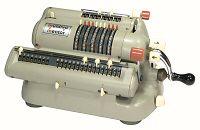 Walther WSR-160 (Muldivo Mentor), S/N 224279
Walther WSR-160 (Muldivo Mentor), S/N 224279
Digits: 10 rotor, 8 counter, 16 accumulator
Dimensions: Body 240W x 160D x 135H, overall width 330mm
Weight: 4.6 kg
Manufactured: Walther, Germany, 1950s and 60s
Walther's post-war production resumed in 1948 with the WSR-160 pin-wheel calculator. Machines intended for sale in England and Commonwealth countries were re-badged as the "Mentor" and sold through the Muldivo organisation. (The Muldivo Calculating Machine Company was established in London in 1912, and acted as importers and distributors for several European manufacturers). The Muldivo nameplate simply states "Foreign manufacture", but retains the Walther model number.
The WSR-160 adds a rotor clearing and back-transfer mechanism to the features of the previous models, with the controls re-arranged for operation with the right hand alone. The accumulator dials retain the serrated thumbwheels to enable manual setting of dividends. The two register clearing handles have been replaced with a single red lever at the right-hand end of the carriage, and a small white control at the lower front. The lever normally clears both registers together, but the control can be set to either side to clear the counter or accumulator alone. The machine has the same carriage shift levers as the previous models, with the release button relocated to the right-hand end of the baseplate.
The rotor setting levers have colour-coded plastic caps which remain stationary as the handle is turned. The white lever at the top right-hand rear is pulled forward to clear the rotor, while the adjacent red lever clears the rotor and engages the back-transfer mechanism. The transfer occurs in a separate operation as the accumulator is cleared. A small button behind the winding handle releases the back-transfer lever if it was engaged accidentally.
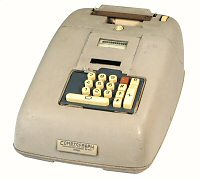 Walther Model P12 (Comptograph Model 101), S/N 107045 C
Walther Model P12 (Comptograph Model 101), S/N 107045 C
Ten-key, electric, 11/12 column
Dimensions: 265W x 425D x 175H
Weight: 9.6kg
Manufactured: Walther, Germany, 1950s
The early Walther ten-key machines were of solid construction with a rather bulbous die-cast casing. The 1950s model range included machines with dual accumulators, Sterling currency, and shuttle carriages for bookkeeping applications. A model with fully-automatic multiplication was introduced in 1959. All the machines were electrically driven and operated at around 200 cycles per minute.
The machine illustrated was originally built to operate in both Sterling and decimal modes, selected by a "Whole Numbers" (WN) key to the left of the keypad. The extra 10 and 11 pence keys were located in the small cut-out above the keypad. The Sterling functions were removed during the decimal currency conversion in 1966.
The Walther P12 was re-badged as the Comptograph 101 and sold by
the Comptometer Corporation in America, or through Comptometer's UK
subsidiary for the Sterling models. The machine illustrated has a
Comptometer (UK) badge with a Walther logo, and was sold in
Australia through the Comptometer agents. When the Model 101 was
discontinued following Comptometer's merger with Victor in 1961, the
Australian agents continued to import the identical Model P12 (and
subsequent machines) directly from Walther.
Walther/Comptograph badge (15kb)
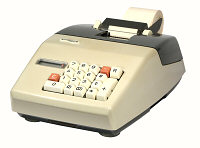 Walther Comptess, Model S33, S/N 1591791
Walther Comptess, Model S33, S/N 1591791
Ten-key, electric, 11/12 column
Dimensions: 220W x 345D x 125H
Weight: 6.6kg
Manufactured: Walther Buromaschinen GmbH, Niederstotzingen, Germany, 1960s
The "Comptess" was introduced in 1963 as a smaller and lighter version of the "Simplex" adding and subtracting machine. It has the usual keys for total, sub-total, non-add, and repeat, and has a powered clearing key. The new styling was applied to all of the 1960s model range.
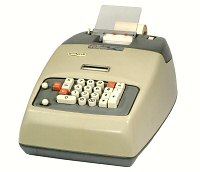 Walther Diwa 32, S/N 2001934-3068042
Walther Diwa 32, S/N 2001934-3068042
Ten-key, electric, 11/12 column, fully automatic ASMD
Dimensions: 260W x 425D x 160H
Weight: 11.2kg
Manufactured: Walther Buromaschinen GmbH, Gerstetten, Germany, 1970-72
The Walther Diwa 32 extends the successful three-function Multa 32 from 1959 to provide fully-automatic multiplication, division, and chain calculations.
Addition and subtraction operate in adding-machine fashion, with total and sub-total keys. Multiplication and division operate algebraically, but with separate "Equals" keys. Every item or result is immediately available for re-use in a subsequent calculation without needing a separate back-transfer operation. The keyboard is relatively simple, with only ten function keys and two sliding levers (for constant storage and accumulation of products).
The mechanism is based on Walther's established technology of pinbox and reciprocating racks, with rotary-gear registers for total, constant, and multiplier storage.
The Diwa 32 was one of the very last of the
full-function mechanical calculators
to be brought to the market. When it was introduced in mid-1970 Walther
was already selling an electronic four-function printing calculator,
but at several times the price. Walther literature from
the period suggests that they expected both product lines to continue
in parallel, with the speed and convenience of the electronic machines
coming at a significant cost premium. However, by the end of 1972 the
introduction of large-scale integration (LSI) had driven the prices to
parity, and the sales of mechanical calculators came to an abrupt end.
The Diwa 32 was discontinued after only two years.
Keyboard detail (29kb)
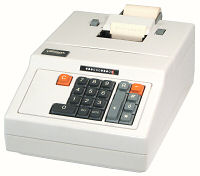 Walther Comptess, S/N 2037581-1733148
Walther Comptess, S/N 2037581-1733148
Ten-key, electric, 11/12 column
Dimensions: 210W x 320D x 130H
Weight: 6.6kg
Manufactured: Walther Buromaschinen GmbH, Gerstetten, Germany, 1972
In early 1972 the entire Walther range was re-packaged into more angular casings, generally similar in style to the new electronic machines. The mechanisms were largely unchanged, although some of the controls were re-arranged to suit the new ISO keyboard standard. The illustration shows the basic Comptess machine in the new design.
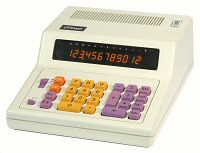 Walther ETR-1031S, S/N 2375451-5051063
Walther ETR-1031S, S/N 2375451-5051063
Technology: MOS-LSI, single chip (Rockwell)
Functions: ASMD, percent, item count, one memory
Digits: 12 (Panaplex)
Dimensions: 205W x 270D x 100H
Weight: 1.8kg
Manufactured: Walther Buromaschinen GmbH, Gerstetten, Germany, 1973
This colourful and well-built machine is a basic four-function calculator which includes a percentage function and a single memory register.
The circuitry uses a Rockwell 15350 single-chip CPU and a Burroughs "Panaplex" 12-digit display. The keyboard uses fully-sealed glass reed switches operated by magnets on the ends of the keystems. The display and CPU in this machine are dated mid-1973.